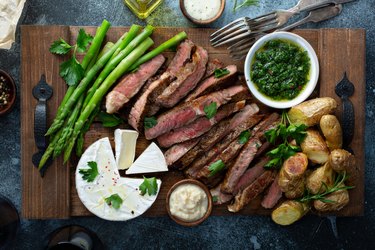Can a Convection Oven Be Used to Cook a Beef Roast

No moisture is needed to cook a ribeye roast, so a dry cooking method like roasting in a convection oven is ideal.
Image Credit: VeselovaElena/iStock/GettyImages
Of the many cuts of beef, prime rib is a popular choice. It's known for being tender and flavorful. And because it is a premium cut, it also tends to be more expensive than other cuts.
Understanding the cuts and grades of beef can be confusing, but everything you need to know about prime ribeye roast is in its name.
Prime refers to the beef grade that manufacturers voluntarily use to label their beef according to the USDA beef grades: prime, choice and select. Prime beef comes from young, well-fed cattle and is known for having good marbling. Roasting is an excellent cooking method for prime rib eye roast. You can also slow-cook prime rib roast.
Rib roast refers to the cut of meat that comes from the primal rib, one of nine primal cuts. Prime cuts tend to have more fat, according to Mayo Clinic. Rib roast is also referred to as ribeye roast, which means the eye of the rib — this cut is boneless, per the University of Nebraska-Lincoln.
If you're unsure how much prime rib you'll need, the Colorado Department of Agriculture recommends 10 ounces per person. Considering ribeye roast shrinks when cooked, it's best to get extra.
Joshua Resnick, the lead chef at the Institute of Culinary Education, recommends cooking a ribeye roast in a convection oven with the following ingredients, tools and methods.
-
Ribeye roast
-
Salt
-
Pepper
-
Herbs like rosemary and thyme
-
Egg whites
-
Roasting pan with rack
-
Butcher's twine
-
Whisk
-
Pastry brush
-
Probe thermometer
-
Cutting board
Step 1: Preheat the Oven
Dry-heat cooking methods like roasting in a convection oven are ideal for ribeye roast. Resnick recommends cooking this cut of beef low and slow. The convection oven will slowly cook the inside of the roast but allow the exterior to become brown and crispy.
Preheat the oven to 225 degrees Fahrenheit. While the oven is preheating, you can prepare your other ingredients.
Step 2: Tie Roast With Butcher's Twine
Butcher's twine is used to tie boneless roasts so they don't lose their shape. You'll need 2 to 3 feet of butcher's twine to wrap around the roast at 2-inch intervals and make a knot at the end.
Tying your roast also makes it easier to carve.
Step 3: Brush the Roast With Egg Whites
An egg wash involves brushing a mixture of egg whites and water onto certain foods before baking or roasting to add shine and a golden exterior. To do this, use a whisk to beat the egg whites until they become frothy.
Place the roast on a cutting board. Use a pastry brush to brush the meat with egg whites. Be sure to coat all sides of the roast.
Step 4: Add Seasoning
Once the roast is coated in egg whites, season the meat liberally with the mixture of salt, pepper, rosemary and thyme. Press the seasonings into all sides of the roast. This will add flavor to the roast, and the salt will draw out moisture.
Step 5: Prep the Roast to Go in the Oven
Transfer the meat to a roasting pan with a rack with the bones facing down. Insert a probe thermometer into the middle of the eye of the ribeye. Set the temperature on the thermometer for the desired doneness.
For a pink, juicy ribeye, Resnick recommends setting the temperature between 130 and 135 F. For a medium-rare ribeye, set it to 140 F.
Step 6: Bake the Roast
The cooking time of a ribeye roast in a convection oven can vary depending on your oven, size of the roast and the desired doneness. Prepare for the roast to cook for 20 to 25 minutes per pound. A 10-pound ribeye roast may need to cook for 3 hours and 20 minutes.
Step 7: Allow the Roast to Rest
After the meat has reached the desired interior temperature, remove it from the oven and allow it to rest for at least 30 minutes to an hour. Resting the meat allows the juices to redistribute into the meat. If you don't let the meat rest, it is likely to be much drier when you carve into it.
Step 8: Remove the Twine and Carve
When the meat is done resting, remove the twine. Carve the roast into thin slices using a carving knife. Resnick recommends a thin and long knife that allows for smooth strokes and prevents the meat from appearing sawed. He recommends against a serrated knife.
Tip
Resnick recommends serving carved slices of the ribeye roast with a jus gravy, which can be made from the drippings from the roast. Alternatively, a horseradish cream sauce adds some spice to cut through the richness of the meat and complement it nicely.
bosworthhimentionce.blogspot.com
Source: https://www.livestrong.com/article/460221-how-to-cook-a-ribeye-roast-in-a-convection-oven/
0 Response to "Can a Convection Oven Be Used to Cook a Beef Roast"
Post a Comment